Impact Quantification of Decentralization in Urban Growth by Extracting Impervious Surfaces Using ISEI in Model Maker
Abstract
1. Introduction
2. Review of Five Existing Comparable Impervious Surface Areas (ISA) Indexes
3. Materials and Methods
3.1. Study Area
3.2. Datasets
3.3. Proposed Index—Impervious Surface Extraction Index (ISEI)
3.4. Growth and Change Analysis Formula
3.5. Index Performance—Accuracy and Background Discrimination
4. Results
4.1. Results of Binary Image Index for the Respective Years
4.2. Change Rate and Growth Rate Calculations and Analyses
4.3. Accuracy Assessment of Results
5. Discussion
5.1. Established Satellite ISA Extraction Indexes
5.2. Impervious Surface Extraction Index (ISEI)
5.3. Indices Accuracy Performance
5.4. Impact of Decentralization on Impervious Surface Areas
6. Conclusions
Author Contributions
Funding
Acknowledgments
Conflicts of Interest
Appendix A
| YEAR | UI | NBAI | EBBI | NBI | NDBI | ISEI | INDICATORS |
|---|---|---|---|---|---|---|---|
| 1984 | 90.48% | 84.78% | 86.96% | 87.50% | 82.61% | 92.00% | Precision |
| 74.51% | 81.25% | 83.33% | 89.36% | 82.61% | 90.20% | Sensitivity | |
| 71.43% | 58.82% | 64.71% | 66.67% | 52.94% | 71.43% | Specificity | |
| 81.72% | 82.98% | 85.11% | 88.42% | 82.61% | 91.09% | F-Score | |
| 73.85% | 75.38% | 78.46% | 83.08% | 74.60% | 86.15% | Overall Accuracy | |
| 1986 | 84.78% | 80.39% | 91.30% | 87.50% | 81.25% | 92.16% | Precision |
| 82.98% | 87.23% | 85.71% | 85.71% | 82.98% | 88.68% | Sensitivity | |
| 61.11% | 44.44% | 75.00% | 62.50% | 50.00% | 66.67% | Specificity | |
| 83.87% | 86.67% | 88.42% | 86.60% | 82.11% | 90.38% | F-Score | |
| 76.92% | 78.38% | 83.08% | 80.00% | 73.85% | 84.62% | Overall Accuracy | |
| 1990 | 86.27% | 89.29% | 88.89% | 90.91% | 85.71% | 93.22% | Precision |
| 83.02% | 89.29% | 90.57% | 90.91% | 90.57% | 94.83% | Sensitivity | |
| 58.82% | 57.14% | 62.50% | 66.67% | 52.94% | 66.67% | Specificity | |
| 84.62% | 89.29% | 89.72% | 90.91% | 88.07% | 94.02% | F-Score | |
| 77.14% | 82.86% | 84.06% | 85.71% | 81.43% | 90.00% | Overall Accuracy | |
| 1995 | 94.44% | 87.27% | 87.50% | 92.86% | 90.74% | 92.98% | Precision |
| 87.93% | 90.57% | 89.09% | 91.23% | 89.09% | 94.64% | Sensitivity | |
| 75.00% | 58.82% | 58.82% | 69.23% | 66.67% | 66.67% | Specificity | |
| 91.07% | 88.89% | 88.29% | 92.04% | 89.91% | 93.91% | F-Score | |
| 85.71% | 82.86% | 81.94% | 87.14% | 84.29% | 89.71% | Overall Accuracy | |
| 2000 | 92.59% | 87.27% | 92.86% | 89.09% | 92.45% | 93.44% | Precision |
| 87.72% | 90.57% | 88.14% | 92.45% | 84.48% | 95.00% | Sensitivity | |
| 73.33% | 63.16% | 69.23% | 64.71% | 71.43% | 66.67% | Specificity | |
| 90.09% | 88.89% | 90.43% | 90.74% | 88.29% | 94.21% | F-Score | |
| 84.72% | 83.33% | 84.72% | 85.71% | 81.94% | 90.28% | Overall Accuracy | |
| 2005 | - | - | - | 61.22% | 78.57% | 93.65% | Precision |
| - | - | - | 69.77% | 77.19% | 92.19% | Sensitivity | |
| - | - | - | 48.65% | 47.83% | 75.00% | Specificity | |
| - | - | - | 65.22% | 77.88% | 92.91% | F-Score | |
| - | - | - | 60.00% | 68.75% | 88.75% | Overall Accuracy | |
| 2010 | 84.85% | 89.23% | 87.69% | 88.06% | 86.15% | 95.71% | Precision |
| 86.15% | 87.88% | 87.69% | 90.77% | 87.50% | 95.71% | Sensitivity | |
| 50.00% | 63.16% | 60.00% | 60.00% | 57.14% | 80.00% | Specificity | |
| 85.50% | 88.55% | 87.69% | 89.39% | 86.82% | 95.71% | F-Score | |
| 77.65% | 82.35% | 81.18% | 83.53% | 80.00% | 92.94% | Overall Accuracy | |
| 2015 | 89.86% | 90.00% | 90.14% | 93.24% | 88.57% | 96.10% | Precision |
| 88.57% | 87.50% | 91.43% | 94.52% | 88.57% | 96.10% | Sensitivity | |
| 65.00% | 61.11% | 65.00% | 70.59% | 60.00% | 76.92% | Specificity | |
| 89.21% | 88.73% | 90.78% | 93.88% | 88.57% | 96.10% | F-Score | |
| 83.33% | 82.22% | 85.56% | 90.00% | 82.22% | 93.33% | Overall Accuracy | |
| 2018 | 91.14% | 89.29% | 92.50% | 92.68% | 91.36% | 96.51% | Precision |
| 87.80% | 91.46% | 90.24% | 92.68% | 90.24% | 96.51% | Sensitivity | |
| 61.11% | 50.00% | 66.67% | 66.67% | 61.11% | 78.57% | Specificity | |
| 89.44% | 90.36% | 91.36% | 92.68% | 90.80% | 96.51% | F-Score | |
| 83.00% | 84.00% | 86.00% | 88.00% | 85.00% | 94.00% | Overall Accuracy |
References
- Terfa, B.K.; Chen, N.; Liu, D.; Zhang, X.; Niyogi, D. Urban Expansion in Ethiopia from 1987 to 2017: Characteristics, Spatial Patterns, and Driving Forces. Sustainbility 2019, 11, 2973. [Google Scholar] [CrossRef]
- Sumari, N.S.; Xu, G.; Ujoh, F.; Korah, P.I.; Ebohon, O.J.; Lyimo, N.N. A Geospatial Approach to Sustainable Urban Planning: Lessons for Morogoro Municipal. Sustainbility 2019, 11, 6508. [Google Scholar] [CrossRef]
- Lemoine, G.; Conway, J.; Baker, J. Agricultural Monitoring—The Need For Better Information; Remote Sensing Exploitation Division, ESRIN: Noordwijk, The Netherlands, 1995. [Google Scholar]
- Liu, J.G.; Mason, P.J. Essential Image Processing and GIS for Remote Sensing; John Wiley & Sons, Inc.: Hoboken, NJ, USA, 2009. [Google Scholar] [CrossRef]
- Uduporuwa, M. An Analysis of Urban Growth and Urbanization in the Sabaragamuwa Province, Sri Lanka. Sabaragamuwa Univ. J. 2010, 9, 115–132. [Google Scholar] [CrossRef]
- Angel, S.; Parent, J.; Civco, D.L.; Blei, A.; Potere, D. The Dimensions of Global Urban Expansion: Estimates and Projections for All Countries, 2000–2050. Prog. Plan. 2011, 75, 53–107. [Google Scholar] [CrossRef]
- Ghosh, S.; Singh, P.; Kumari, M. Assessment of Urban Sprawl and Land Use Change Dynamics, Using Remote Sensing Technique. A Study of Kolkata and Surrounding Perphery, WB, India. In Proceedings of the NGCT 2017: 3rd International Conference on Next Generation Computing Technologies-Springer, Scopus, SCIE, Web of Science, DBLP, Dehradun, India, 30–31 October 2017. [Google Scholar]
- United Nations office for Economic and Social Affairs. World Urbanizationprospects: The 2018 Revision; United Nations: New York, NY, USA, 2018. [Google Scholar]
- Frazer, L. Paving Paradise: The Peril of Impervious Surfaces. Environ. Health Perspect. 2005, 113, 8. [Google Scholar] [CrossRef] [PubMed]
- Salahat, E.; Qasaimeh, M. Recent Advances in Features Extraction and Description Algorithms: A Comprehensive Survey. In Proceedings of the 2017 IEEE International Conference on Industrial Technology (ICIT), Toronto, ON, Canada, 22–25 March 2017; pp. 1059–1063. [Google Scholar] [CrossRef]
- Shao, Z.; Liu, C. The Integrated Use of DMSP-OLS Nighttime Light and MODIS Data for Monitoring Large-Scale Impervious Surface Dynamics: A Case Study in the Yangtze River Delta. Remote Sens. 2014, 6, 9359–9378. [Google Scholar] [CrossRef]
- Liu, C.; Shao, Z.; Chen, M.; Luo, H. MNDISI: A Multi-Source Composition Index for Impervious Surface Area Estimation at the Individual City Scale. Remote Sens. Lett. 2013, 4, 803–812. [Google Scholar] [CrossRef]
- Zhang, L.; Weng, Q.; Shao, Z. An Evaluation of Monthly Impervious Surface Dynamics by Fusing Landsat and MODIS Time Series in the Pearl River Delta, China, from 2000 to 2015. Remote Sens. Environ. 2017, 201, 99–114. [Google Scholar] [CrossRef]
- Shao, Z.; Wang, L.; Wang, Z.; Deng, J. Remote Sensing Image Super-Resolution Using Sparse Representation and Coupled Sparse Autoencoder. IEEE J. Sel. Top. Appl. Earth Obs. Remote Sens. 2019, 12, 2663–2674. [Google Scholar] [CrossRef]
- Song, X.P.; Sexton, J.O.; Huang, C.; Channan, S.; Townshend, J.R. Characterizing the Magnitude, Timing and Duration of Urban Growth from Time Series of Landsat-Based Estimates of Impervious Cover. Remote Sens. Environ. 2016, 175, 1–13. [Google Scholar] [CrossRef]
- Li, X.; Zhou, Y.; Zhu, Z.; Liang, L.; Yu, B.; Cao, W. Mapping Annual Urban Dynamics ( 1985–2015 ) Using Time Series of Landsat Data. Remote Sens. Environ. 2018, 216, 674–683. [Google Scholar] [CrossRef]
- Forest, A.; Woodcock, C.E.; Macomber, S.A.; Pax-lenney, M.; Cohen, W.B. Monitoring Large Areas for Forest Change Using Landsat: Generalization across Space, Time and Landsat Sensors. Remote Sens. Environ. 2001, 78, 194–203. [Google Scholar]
- Mohammady, S.; Delavar, M.R.; Pijanowski, B.C. Urban Growth Modelling with Artificial Neural Network and Logistic Regression. Case Study: Sanandaj City, Iran. Rom. Rev. Reg. Stud. 2013, IX, 47–60. [Google Scholar]
- Mertes, C.M.; Schneider, A.; Sulla-Menashe, D.; Tatem, A.J.; Tan, B. Detecting Change in Urban Areas at Continental Scales with MODIS Data. Remote Sens. Environ. 2015, 158, 331–347. [Google Scholar] [CrossRef]
- Malik, R.; Ali, M. The Impact of Urbanization on Agriculture Sector: A Case Study of Peshawar, Pakistan. J. Resour. Dev. Manag. 2015, 8, 79–86. [Google Scholar]
- Li, D.; Ma, J.; Cheng, T.; van Genderen, J.L.; Shao, Z. Challenges and Opportunities for the Development of MEGACITIES. Int. J. Digit. Earth 2018, 15, 1–14. [Google Scholar] [CrossRef]
- Shao, Z.; Fu, H.; Fu, P.; Yin, L. Mapping Urban Impervious Surface by Fusing Optical and SAR Data at the Decision Level. Remote Sens. 2016, 8, 945. [Google Scholar] [CrossRef]
- Yin, J.; Yin, Z.; Zhong, H.; Xu, S.; Hu, X.; Wang, J.; Wu, J. Monitoring Urban Expansion and Land Use/Land Cover Changes of Shanghai Metropolitan Area during the Transitional Economy (1979–2009) in China. Environ. Monit. Assess. 2011, 177, 609–621. [Google Scholar] [CrossRef]
- Dafflon, B.; Madies, T. The Political Economy of Decentralization in Sub-Saharan Africa—A New Implementation Model in Burkina Faso, Ghana, Kenya and Senegal; Africa Development Forum: Washigton, DC, USA, 2013. [Google Scholar]
- Hanna, N.; Picciotto, R.; Crook, R.; Manor, J. Democratic Decentralization. In Making Development Work: Development Learning in a Word of Poverty and Wealth; Taylor & Francis Group: New York, NY, USA, 2019. [Google Scholar] [CrossRef]
- Andr’e, P.; Mespl’e-Somps, S. Politics and the Geographic Allocation of Public Funds in a Semi-Democracy. The Case of Ghana, 1996–2004. In The Allocation of Public Goods and National Elections in Ghana; MPRA: Paris, France, 2011. [Google Scholar]
- Dickovick, J.T.; Wunsch, J.S. Decentralization in Africa: The Paradox of State Strength; Lynne Rienner Publisher: Boulder, CO, USA, 2015; Volume 45. [Google Scholar] [CrossRef]
- Crook, R. Decentralisation and Good Governance. In Federalism in a Changing World-Learning from Each Other; McGill-Queen’s University Press: Montreal, QC, Canada; Kingston, ON, Canada; London, UK, 2002. [Google Scholar]
- Ahwoi, K. Rethinking Decentralization and Local Government in Ghana—Proposals for Amendment; AfricalPortal: Accra, Ghana, 2010. [Google Scholar]
- Hoffman, B.D.; Metzroth, K.M. The Political Economy of Decentralization in Ghana; Centre for Democracy and Civil Society, Georgetown University: Washington, DC, USA, 2010. [Google Scholar]
- Schug, F.; Okujeni, A.; Hauer, J.; Hostert, P.; Nielsen, J.Ø.; van der Linden, S. Mapping Patterns of Urban Development in Ouagadougou, Burkina Faso, Using Machine Learning Regression Modeling with Bi-Seasonal Landsat Time Series. Remote Sens. Environ. 2018, 210, 217–228. [Google Scholar] [CrossRef]
- Sanyare, F.N. Decentralised Local Governance and Community Development: Empirical Perspectives from Northern Ghana. Univ. Manch. 2013. [Google Scholar] [CrossRef]
- White, M.D.; Greer, K.A. The Effects of Watershed Urbanization on the Stream Hydrology and Riparian Vegetation of Los Peñasquitos Creek, California. Landsc. Urban Plan. 2006, 74, 125–138. [Google Scholar] [CrossRef]
- Sugg, Z.P.; Finke, T.; Goodrich, D.C.; Moran, M.S.; Yool, S.R.; Finke, T.; Sugg, Z.P.; Yool, S.R.; Moran, M.S. Mapping Impervious Surfaces Using Object-Oriented Classification in a Semiarid Urban Region. Photogramm. Eng. Remote Sens. 2014, 80, 343–352. [Google Scholar] [CrossRef]
- Wu, C. Normalized Spectral Mixture Analysis for Monitoring Urban Composition Using ETM+ Imagery. Remote Sens. Environ. 2004, 93, 480–492. [Google Scholar] [CrossRef]
- Waqar, M.M.; Mirza, J.F.; Mumtaz, R.; Hussain, E. Development of New Indices for Extraction of Built-Up Area {&} Bare Soil. Open Access Sci. Rep. 2012, 1, 1–4. [Google Scholar] [CrossRef]
- Sun, Z.; Wang, C.; Guo, H.; Shang, R. A Modified Normalized Difference Impervious Surface Index (MNDISI) for Automatic Urban Mapping from Landsat Imagery. Remote Sens. 2017, 9, 942. [Google Scholar] [CrossRef]
- As-syakur, A.R.; Adnyana, I.W.S.; Arthana, I.W.; Nuarsa, I.W. Enhanced Built-UP and Bareness Index (EBBI) for Mapping Built-UP and Bare Land in an Urban Area. Remote Sens. 2012, 4, 2957–2970. [Google Scholar] [CrossRef]
- Sekertekin, A.; Abdikan, S.; Marangoz, A.M. The Acquisition of Impervious Surface Area from LANDSAT 8 Satellite Sensor Data Using Urban Indices: A Comparative Analysis. Environ. Monit. Assess. 2018, 190, 1–13. [Google Scholar] [CrossRef]
- Zha, Y.; Gao, J.; Ni, S. Use of Normalized Difference Built-up Index in Automatically Mapping Urban Areas from TM Imagery. Int. J. Remote Sens. 2003, 24, 583–594. [Google Scholar] [CrossRef]
- Hidayati, I.N.; Suharyadi, R.; Danoedoro, P. Developing an Extraction Method of Urban Built-Up Area Based on Remote Sensing Imagery Transformation Index. Forum Geogr. 2018, 32, 96–108. [Google Scholar] [CrossRef]
- Chen, J.; Li, M.; Liu, Y.; Shen, C.; Hu, W. Extract Residential Areas Automatically by New Built-up Index. In Proceedings of the 2010 18th International Conference on Geoinformatics, Geoinformatics 2010, Beijing, China, 18–20 June 2010. [Google Scholar]
- Wang, Z.; Gang, C.; Li, X.; Chen, Y.; Li, J. Application of a Normalized Difference Impervious Index (NDII) to Extract Urban Impervious Surface Features Based on Landsat TM Images. Int. J. Remote Sens. 2015, 36, 1055–1069. [Google Scholar] [CrossRef]
- UNDP. Wa Municipal Assembly Human Development Report 2011 And The Attainment Of Mdgs Development; UNDP: New York, NY, USA, 2011. [Google Scholar]
- Ghana Statistical Service. District Analytical Report—Wa Municipality; Ghana Statistical Service: Washington, DC, USA, 2014. [Google Scholar]
- Aduah, M.S.; Aabeyir, R. Land Cover Dynamics in Wa Municipality, Upper West Region of Ghana. Res. J. Environ. Earth Sci. 2012, 4, 658–664. [Google Scholar]
- Azmi, R.; Alami, O.B.; Saadane, A.E.; Kacimi, I.; Chafiq, T. A Modified and Enhanced Normalized Built-up Index Using Multispectral and Thermal Bands. Indian J. Sci. Technol. 2016, 9, 1–10. [Google Scholar] [CrossRef]
- Sameen, M.I.; Pradhan, B. A Novel Built-up Spectral Index Developed by Using Multiobjective Particle-Swarm-Optimization Technique. In Proceedings of the 8th IGRSM International Conference and Exhibition on Remote Sensing & GIS (IGRSM 2016) IOP, Kuala Geospatial, Malaysia, 13–14 April 2016. [Google Scholar]
- Phiri, L.; Nyirenda, E. Urban Growth Analysis for Lusaka City Using Remote Sensing and GIS. In Proceedings of the DII-2015 Conference (Development and Investment in Infrastructure Conference), Livingstone, Zambia, 16–18 September 2015. [Google Scholar]
- Li, L.; Lu, D.; Kuang, W. Examining Urban Impervious Surface Distribution and Its Dynamic Change in Hangzhou Metropolis. Remote Sens. 2016, 8, 265. [Google Scholar] [CrossRef]
- Xu, H.; Lin, D.; Tang, F.; Wei, C. Remote Sensing of Impervious Surface Dynamics of Xiamen City, Southeastern China. In Proceedings of the 2011 19th International Conference on Geoinformatics, Shanghai, China, 24–26 June 2011. [Google Scholar]
- Feeney, G. Demography 101: Population Growth Rates. The Demography-Statistics-Information Technology Letter. New York, NY, USA, 2014. Available online: http://demographer.com/dsitl/09-d101-population-growth-rates/DSITL09-D101-population-growth-rates.pdf (accessed on 12 September 2019).
- Liu, S.H.; Wu, C.J.; Shen, H.Q. A GIS BasedM Odel of Urban Land Use Growth in Be Ij Ing. Acta Geogr. Sin. 2000, 55, 407–416. [Google Scholar]
- Baratloo, A.; Hosseini, M.; Negida, A.; El Ashal, G. Part 1: Simple Definition and Calculation of Accuracy, Sensitivity and Specificity. Emerg 2015, 3, 48–49. [Google Scholar]
- Tharwat, A. Classification Assessment Methods. Appl. Comput. Inform. 2018. [Google Scholar] [CrossRef]
- Twumasi, N.Y.D.; Shao, Z.; Altan, O. Mapping Built-Up Areas Using Two Band Ratio on Landsat Imagery of Accra in Ghana from 1980 to 2017. Appl. Ecol. Environ. Res. 2019, 17, 13147–13168. [Google Scholar]
- Hu, Q.; Wu, W.; Xia, T.; Yu, Q.; Yang, P.; Li, Z.; Song, Q. Exploring the Use of Google Earth Imagery and Object-Based Methods in Land Use/Cover Mapping. Remote Sens. 2013, 5, 6026–6042. [Google Scholar] [CrossRef]
- Oteng-Ababio, M.; Owusu, G.; Asafo, D.M. Following the Footsteps: Urbanisation of Wa Municipality and Its Synergism in Risk Accumulation, Uncertainties and Complexities in Urban Ghana. Jàmbá J. Disaster Risk Stud. 2019, 11, 1–10. [Google Scholar] [CrossRef]
- Ghana Statistical Service. 2010 Population & Housing Census-National Analytical Report; Ghana Statistical Service: Washington, DC, USA, 2013. [Google Scholar]
- UNFPA. Population-Situation—Analysis-(PSA): A Conceptual and Methodological Guide; UNFPA: New York, NY, USA, 2010. [Google Scholar]
- Stathakis, D.; Perakis, K.; Savin, I. Efficient Segmentation of Urban Areas by the VIBI. Int. J. Remote Sens. 2012, 33, 6361–6377. [Google Scholar] [CrossRef]
- He, C.; Shi, P.; Xie, D.; Zhao, Y. Improving the Normalized Difference Built-up Index to Map Urban Built-up Areas Using a Semiautomatic Segmentation Approach. Remote Sens. Lett. 2010, 1, 213–221. [Google Scholar] [CrossRef]
- Valdiviezo-N, J.C.; Téllez-Quiñones, A.; Salazar-Garibay, A.; López-Caloca, A.A. Built-up Index Methods and Their Applications for Urban Extraction from Sentinel 2A Satellite Data: Discussion. J. Opt. Soc. Am. A 2017, 35, 35. [Google Scholar] [CrossRef] [PubMed]
- Dapilah, F.; Nielsen, J.Ø.; Akongbangre, J.N. Peri-Urban Transformation and Shared Natural Resources: The Case of Shea Trees Depletion and Livelihood in Wa Municipality, Northwestern Ghana. African Geogr. Rev. 2018, 6812, 1–16. [Google Scholar] [CrossRef]
- Owusu, G.; Oteng-Ababio, M. Moving Unruly Contemporary Urbanism Toward Sustainable Urban Development in Ghana by 2030. Am. Behav. Sci. 2015, 59, 311–327. [Google Scholar] [CrossRef]
- Peprah, K. Urban Sprawl of Wa, Ghana: Socio-Economic Implications for Small-Holder Farmers. Int. J. Innov. Res. Dev. 2014, 3, 277–287. [Google Scholar]
- Osumanu, I.K.; Akongbangre, J.N.; Tuu, G.N.Y.; Owusu-Sekyere, E. From Patches of Villages to a Municipality: Time, Space, and Expansion of Wa, Ghana. Urban Forum 2019, 30, 57–74. [Google Scholar] [CrossRef]
- Schneider, A. Decentralization: Conceptualization. Stud. Comp. Int. Dev. 2003, 38, 32–56. [Google Scholar] [CrossRef]
- Hanna, W.J.; Hanna, J.L. An Interdisciplinary Approach, Urban Dynamincs in Black Africa, 2nd ed.; Taylor & Francis Group: Abingdon, UK, 1981. [Google Scholar]
- The World Bank Group. Rising through Cities in Ghana: Ghana Urbanization Review Overview Report; The World Bank Group: Washington, DC, USA, 2015. [Google Scholar]
- Sinha, P.; Verma, N.K.; Ayele, E. Urban Built-up Area Extraction and Change Detection of Adama Municipal Area Using Time-Series Landsat Images. Int. J. Adv. Remote Sens. GIS 2016, 5, 1886–1895. [Google Scholar] [CrossRef]
- Shao, Z.; Fu, H.; Li, D.; Altan, O.; Cheng, T. Remote Sensing Monitoring of Multi-scale Watersheds Impermeability for Urban Hydrological Evaluation. Remote Sens. Environ. 2019, 232, 111338. [Google Scholar] [CrossRef]
- Shao, Z.; Cai, J.; Fu, P.; Hu, L.; Liu, T. Deep Learning-based Fusion of Landsat-8 and Sentinel-2 Images for a Harmonised Surface Reflectance Product. Remote Sens. Environ. 2019, 235, 111425. [Google Scholar] [CrossRef]
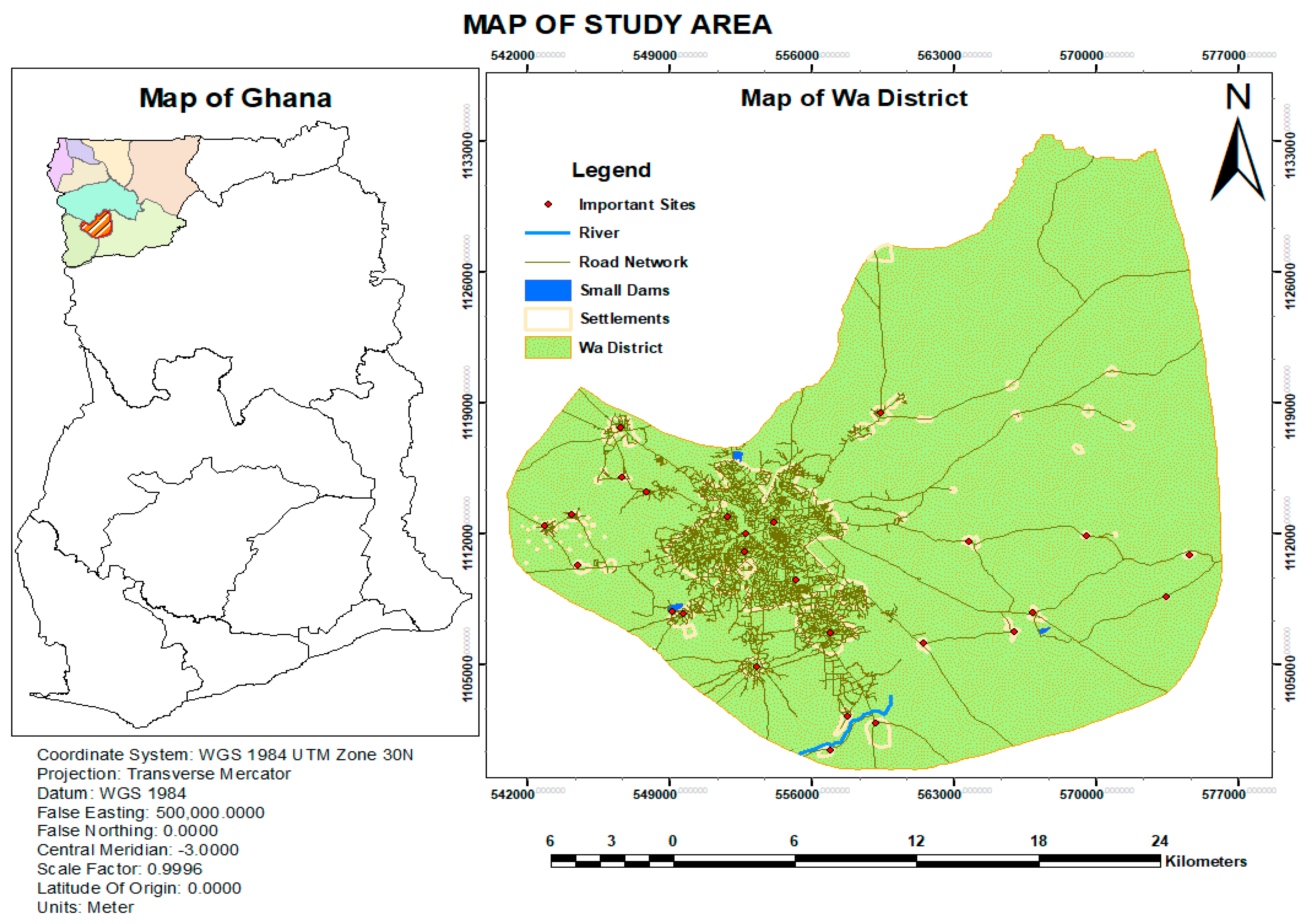



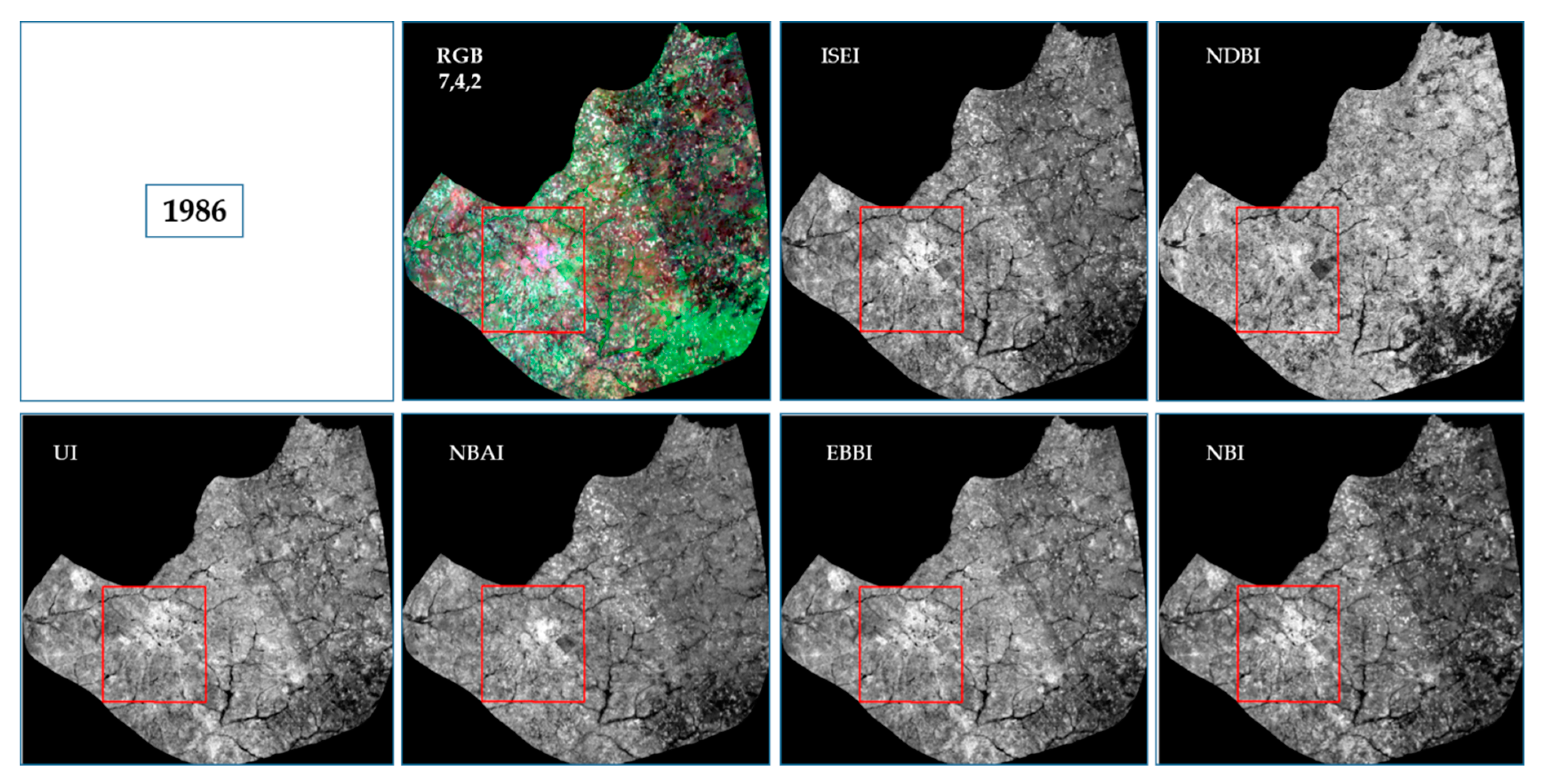

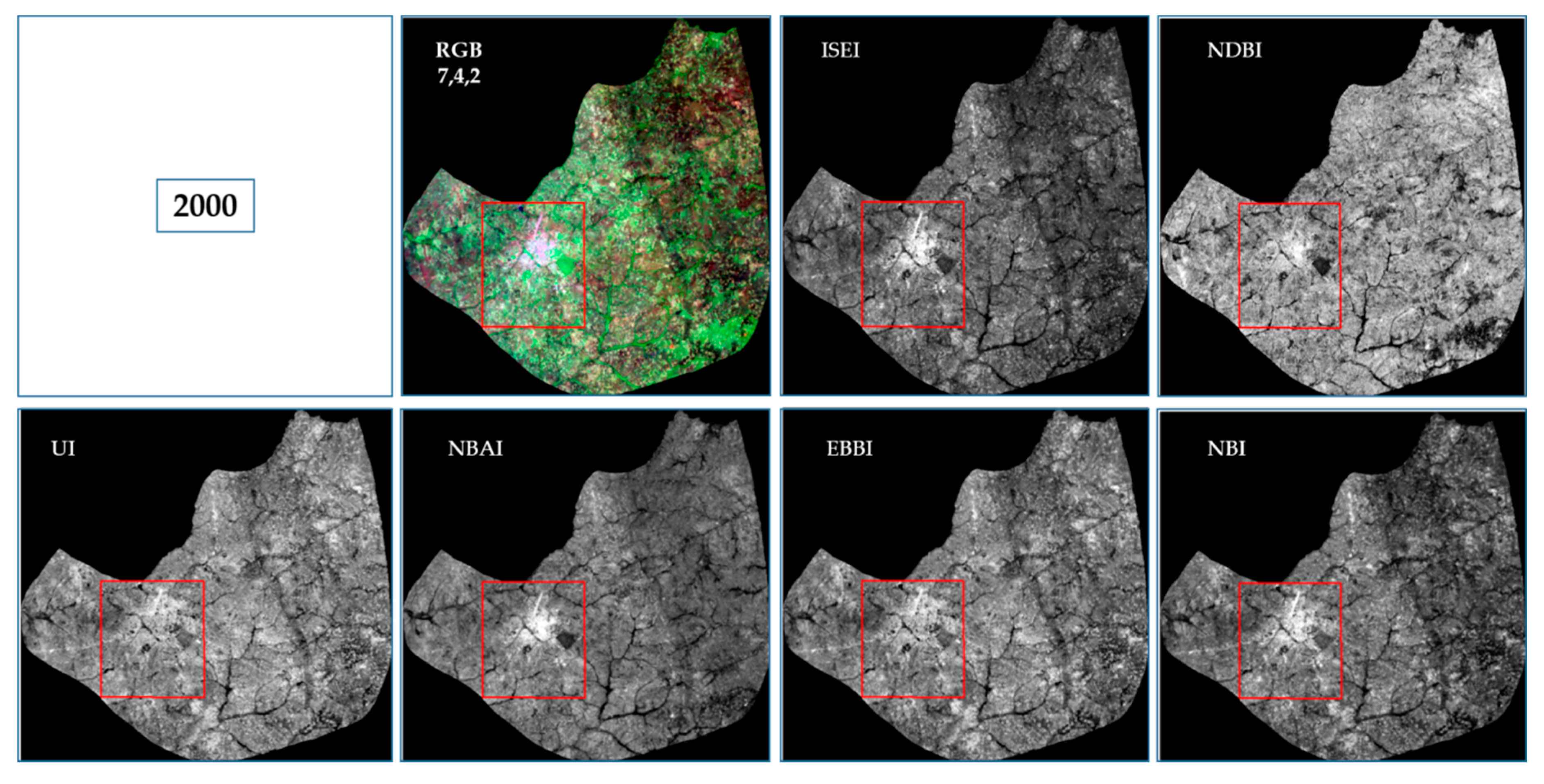
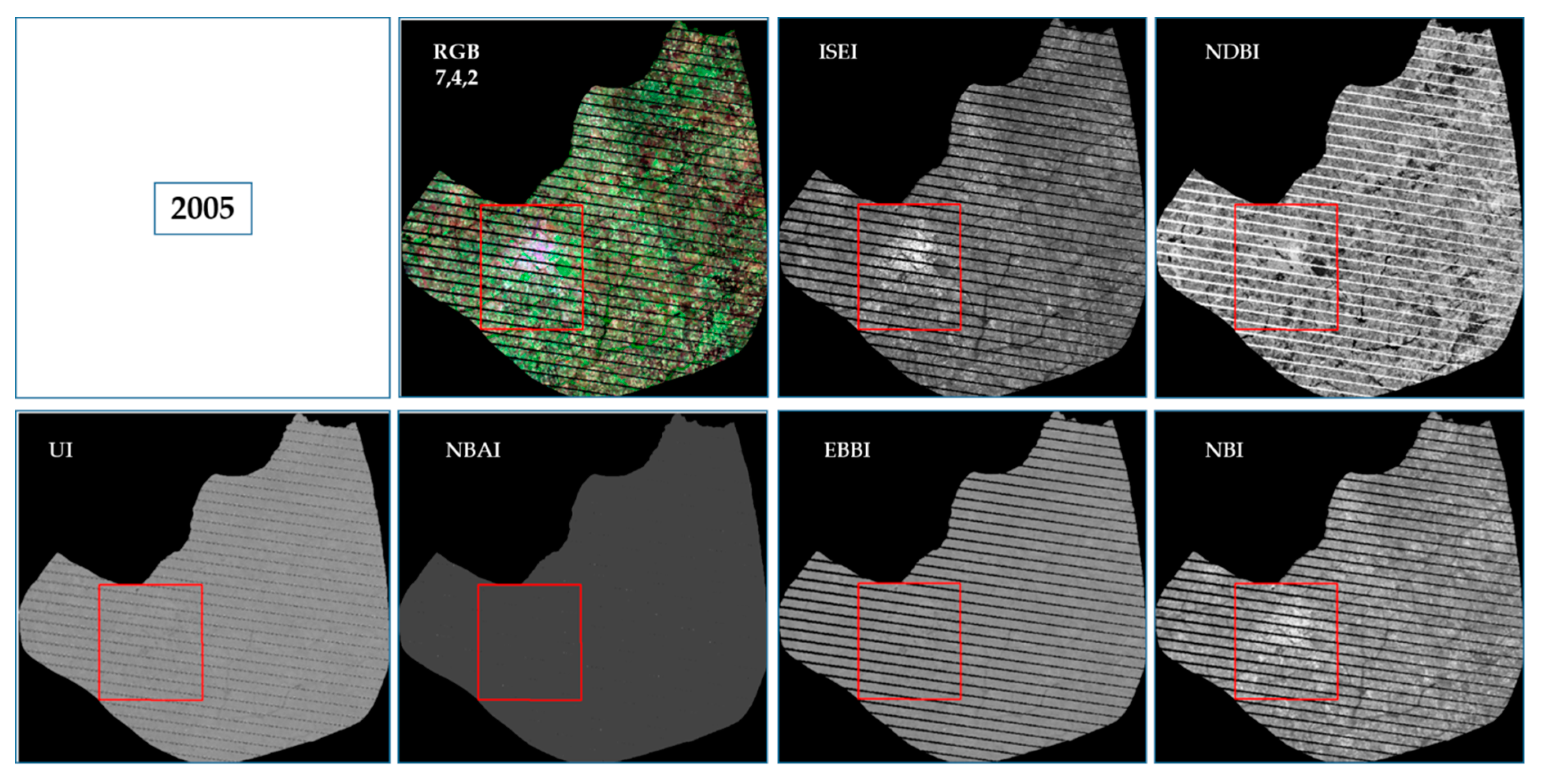
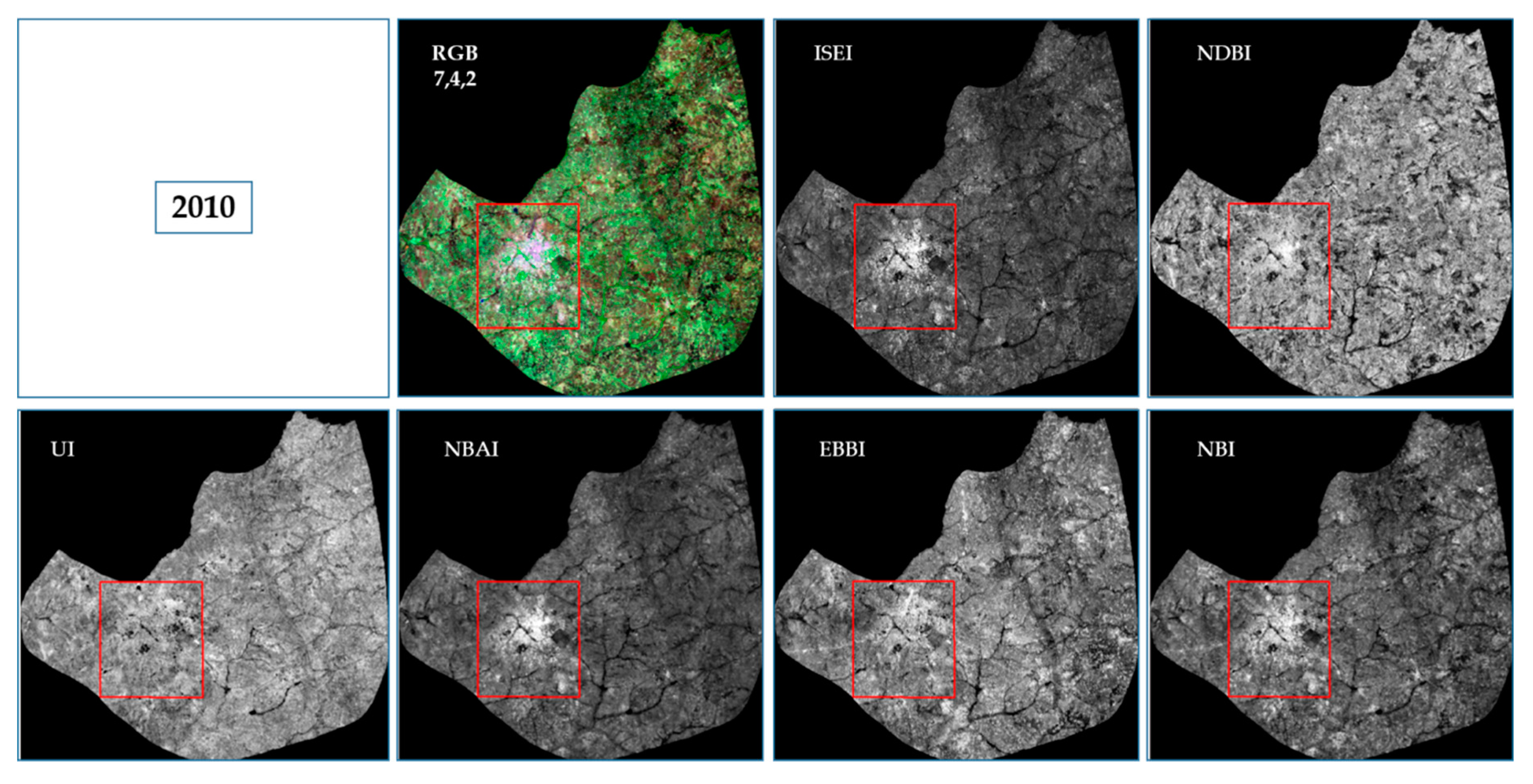
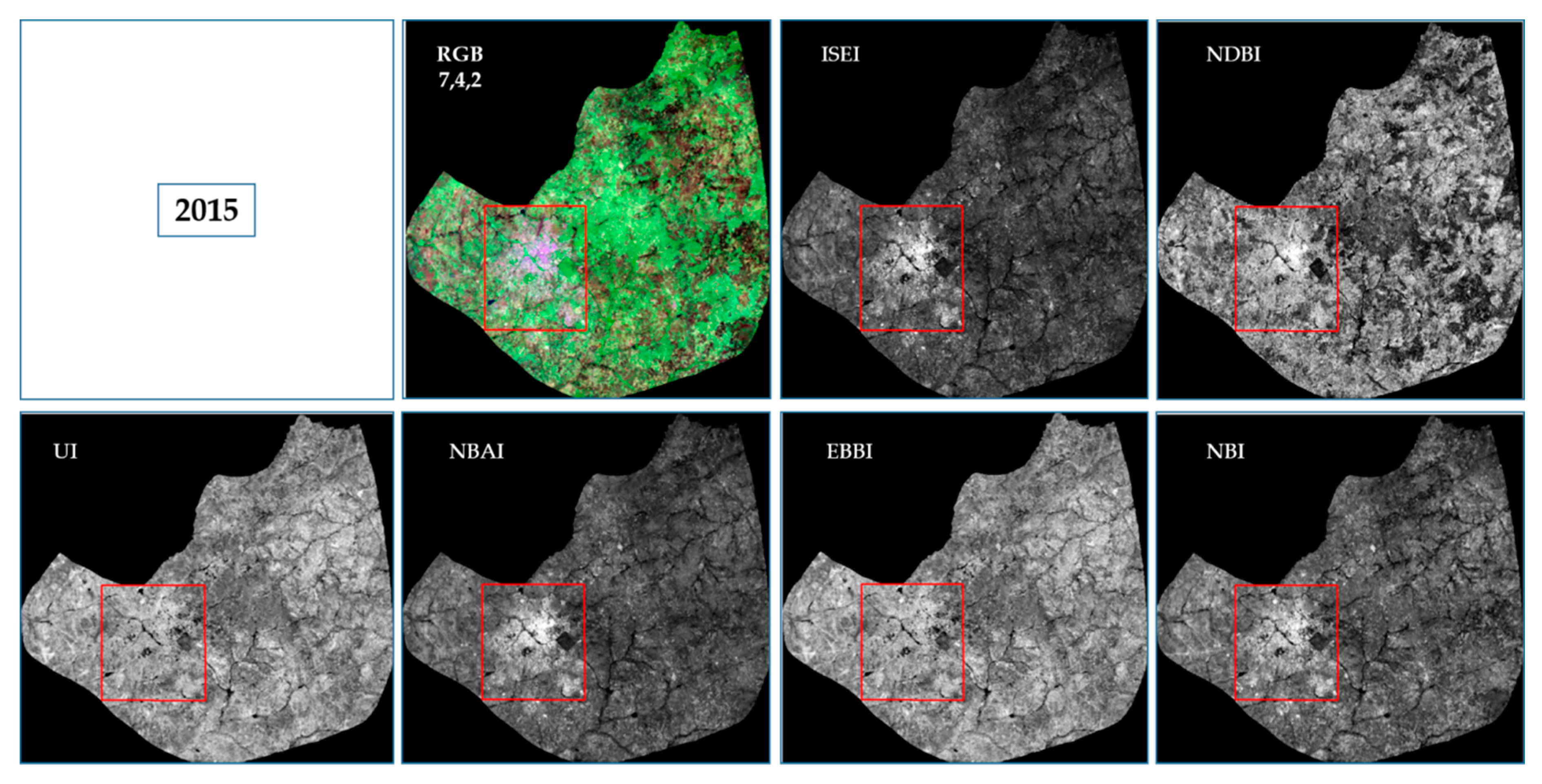
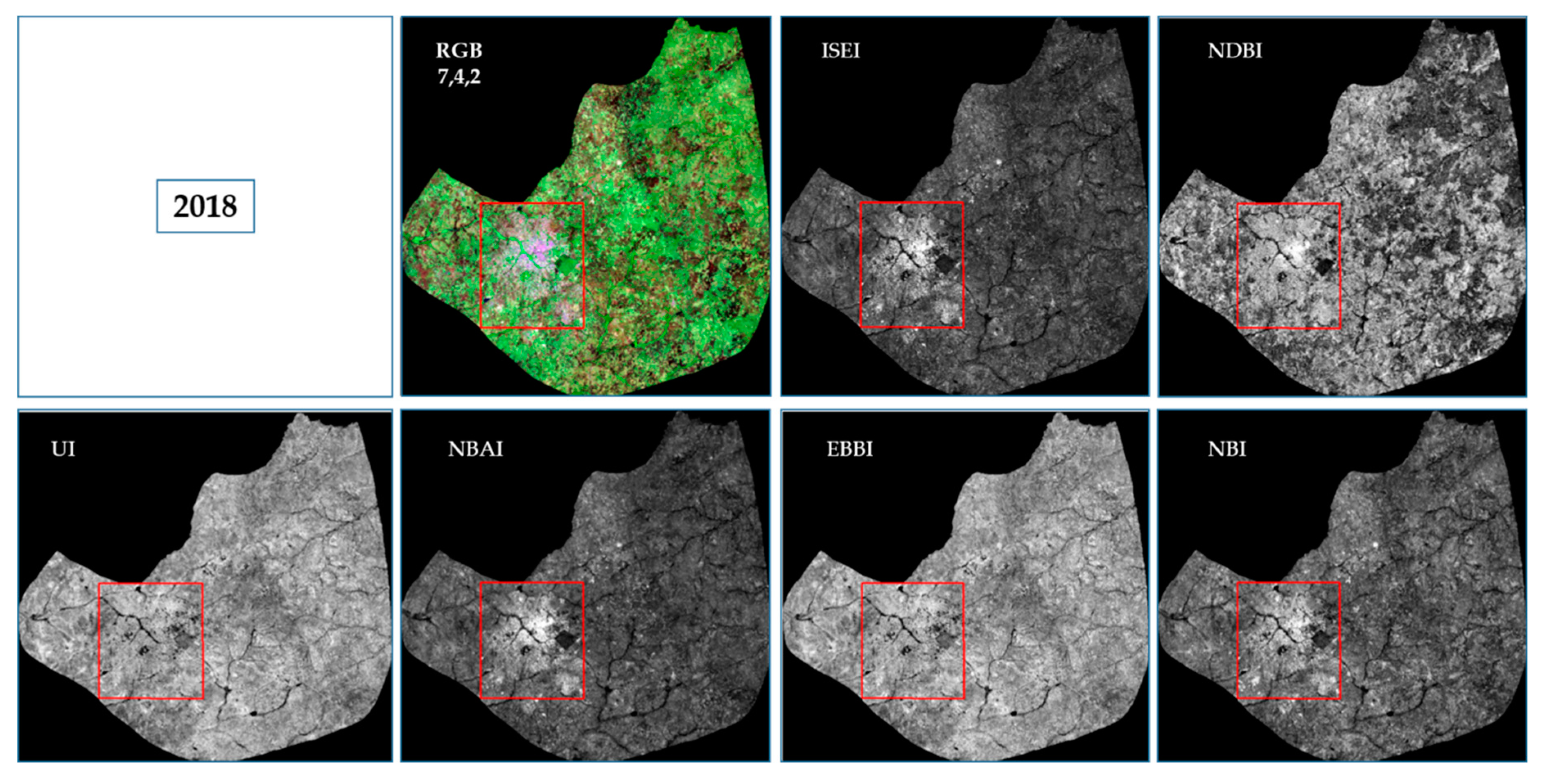
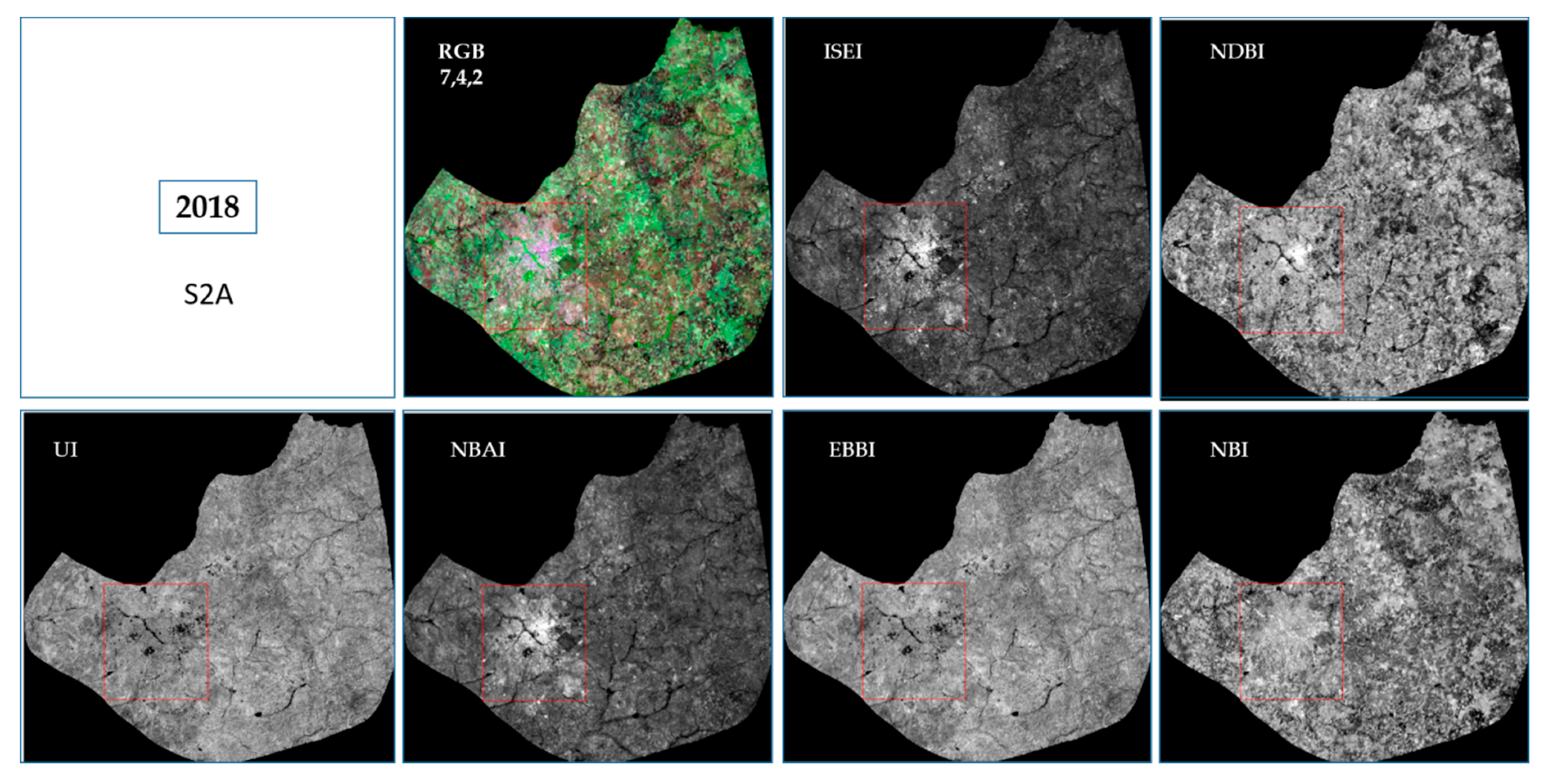
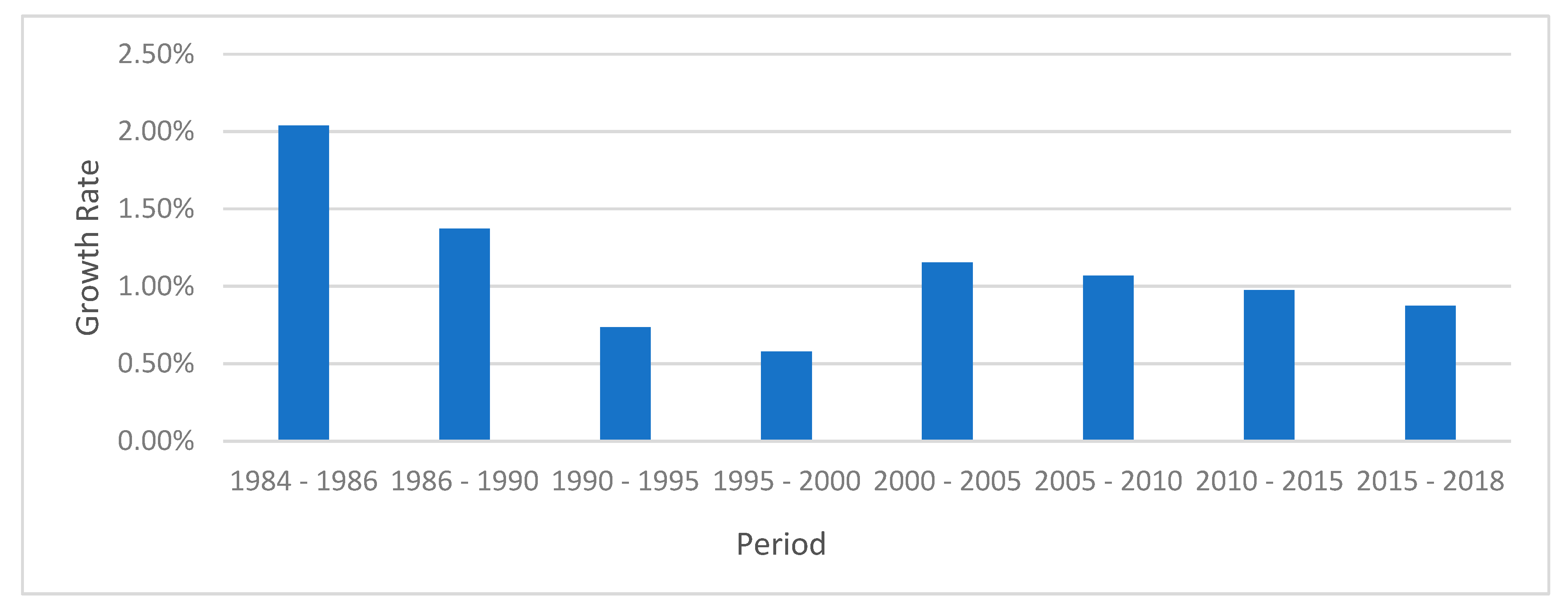
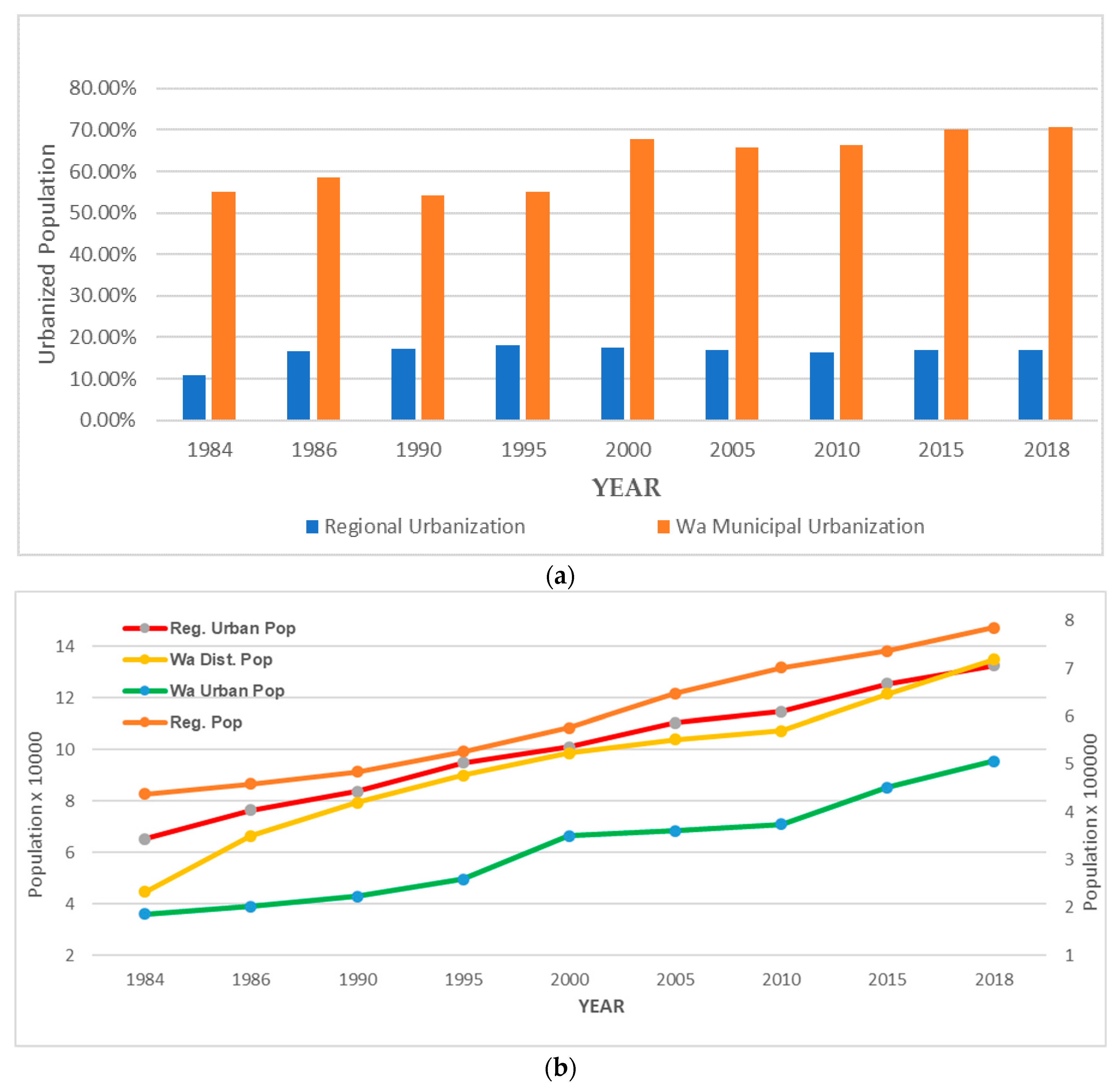

| Band Name | Landsat 5 TM | Landsat 7 ETM+ | Landsat 8 OLI | Sentinel 2A (1C) | Pixel Size | Year | Type | Acquisition Date | Image Size |
|---|---|---|---|---|---|---|---|---|---|
| Blue | B1 (0.45–0.52) | B1 (0.45–0.52) | B2 (0.45–0.51) | B2 (0.490) | 30; 10 | 1984 | TM 5 | 09/Sep/1984 | 170 × 183 |
| Green | B2 (0.52–0.60) | B2 (0.52–0.60) | B3 (0.53–0.59) | B3 (0.560) | 30; 10 | 1986 | TM 5 | 20/Dec/1986 | 170 × 183 |
| Red | B3 (0.63–0.69) | B3 (0.63–0.69) | B4 (0.64–0.67) | B4 (0.665) | 30; 10 | 1990 | TM 5 | 15/Dec/1990 | 170 × 183 |
| NIR | B4 (0.76–0.90) | B4 (0.77–0.90) | B5 (0.85–0.88) | B8 (0.842) | 30; 10 | 1995 | TM 5 | 07/Aug/1995 | 170 × 183 |
| SWIR 1 | B5 (1.55–1.75) | B5 (1.55–1.75) | B6 (1.57–1.65) | B11 (1.610) | 30; 20 | 2000 | ETM+ | 18/Dec/2000 | 170 × 183 |
| SWIR 2 | B7 (2.08–2.35) | B7 (2.09–2.35) | B7 (2.11–2.29) | B12 (2.190) | 30; 20 | 2005 | ETM+ | 16/Dec/2005 | 170 × 183 |
| 2010 | TM 5 | 22/Dec/2010 | 170 × 183 | ||||||
| 2015 | OLI | 20/Dec/2015 | 180 × 185 | ||||||
| 2018 | OLI | 12/Dec/2018 | 180 × 185 | ||||||
| 2018 | SENT 2A | 21/Dec/2018 | 100 × 100 |
| Year | Built-Up Areas (ISA) in km2 | Wa District (%) | Wa Municipal (%) | Wa Township (%) |
|---|---|---|---|---|
| 1984 | 201.89 | 3.70 | 18.73 | 34.81 |
| 1986 | 210.20 | 3.85 | 19.50 | 36.24 |
| 1990 | 221.96 | 4.07 | 20.59 | 38.27 |
| 1995 | 230.24 | 4.22 | 21.36 | 39.70 |
| 2000 | 236.98 | 4.34 | 21.98 | 40.86 |
| 2005 | 250.96 | 4.60 | 23.28 | 43.27 |
| 2010 | 264.65 | 4.85 | 24.55 | 45.63 |
| 2015 | 277.81 | 5.09 | 25.77 | 47.90 |
| 2018 | 285.15 | 5.22 | 26.45 | 49.16 |
| YEAR | UI | NBAI | EBBI | NBI | NDBI | ISEI | INDICATOR |
|---|---|---|---|---|---|---|---|
| 1984 | 73.85% | 75.38% | 78.46% | 83.08% | 74.60% | 86.15% | Overall Accuracy |
| 1986 | 76.92% | 78.38% | 83.08% | 80.00% | 73.85% | 84.62% | Overall Accuracy |
| 1990 | 77.14% | 82.86% | 84.06% | 85.71% | 81.43% | 90.00% | Overall Accuracy |
| 1995 | 85.71% | 82.86% | 81.94% | 87.14% | 84.29% | 89.71% | Overall Accuracy |
| 2000 | 84.72% | 83.33% | 84.72% | 85.71% | 81.94% | 90.28% | Overall Accuracy |
| 2005 | - | - | - | 60.00% | 68.75% | 88.75% | Overall Accuracy |
| 2010 | 77.65% | 82.35% | 81.18% | 83.53% | 80.00% | 92.94% | Overall Accuracy |
| 2015 | 83.33% | 82.22% | 85.56% | 90.00% | 82.22% | 93.33% | Overall Accuracy |
| 2018 | 83.00% | 84.00% | 86.00% | 88.00% | 85.00% | 94.00% | Overall Accuracy |
| Year | Regional Population | Wa Dist’ (Municipal) | Regional Urban Pop | Wa Urban Population | Regional Urbanization | Wa Mun. Urbanization |
|---|---|---|---|---|---|---|
| 1984 | 438,008 | 65,354 | 47,742 | 36,067 | 10.9% | 55.19% |
| 1986 | 458,594 | 66,444 | 76,431 | 38,954 | 16.7% | 58.63% |
| 1990 | 484,592 * | 79,379 | 83,649 | 42,950 | 17.3% | 54.11% |
| 1995 | 526,343 | 90,084 | 94,958 | 49,605 | 18.0% | 55.07% |
| 2000 | 576,583 | 98,675 | 100,902 | 66,441 | 17.5% | 67.73% |
| 2005 | 648,658 * | 103,856 * | 110,487 | 68,486 | 17.0% | 65.94% |
| 2010 | 702,110 | 107,214 | 114,653 | 71,051 | 16.3% | 66.27% |
| 2015 | 737,215 | 121,689 | 125,543 | 85,261 | 17.0% | 70.06% |
| 2018 | 785,199 | 135,000 | 132,698 | 95,491 | 16.9% | 70.73% |
| Period | G R R. Pop. | G R D. Pop. | Change Rate | Growth Rate | Ann. ISA Inc. | Urban Growth |
|---|---|---|---|---|---|---|
| 1984–1986 | 8.14% | 3.93% | 36.23% | 2.04% | 0.39% | 4.12% |
| 1986–1990 | 4.62% | 5.00% | 38.09% | 1.37% | 0.27% | 5.59% |
| 1990–1995 | 6.55% | 7.47% | 39.95% | 0.74% | 0.15% | 3.73% |
| 1995–2000 | 3.08% | 15.73% | 41.34% | 0.58% | 0.13% | 2.93% |
| 2000–2005 | 4.64% | 1.53% | 43.26% | 1.15% | 0.26% | 5.90% |
| 2005–2010 | 1.87% | 1.86% | 45.83% | 1.07% | 0.25% | 5.46% |
| 2010–2015 | 4.64% | 9.54% | 48.32% | 0.98% | 0.24% | 4.97% |
| 2015–2018 | 2.81% | 5.83% | 50.22% | 0.87% | 0.23% | 2.64% |
| YEAR | UI | NBAI | EBBI | NBI | NDBI | ISEI | RANGE |
|---|---|---|---|---|---|---|---|
| 1984 | 1.10972 | 0 | 0.0079212 | 0.246518 | 0 | 0.648605 | max |
| 0 | −0.439463 | −0.042412 | 0 | −0.448671 | 0 | min | |
| 1986 | 1.57745 | 0 | 0.0513746 | 0.494804 | 0.479347 | 0.606685 | max |
| 0 | −0.868018 | −0.014118 | 0 | −0.271827 | 0 | min | |
| 1990 | 1.62941 | 0 | 0.0536924 | 0.478664 | 0.729015 | 0.681482 | max |
| 0 | −1.01229 | −0.020217 | 0 | −1.17461 | 0 | min | |
| 1995 | 1.46634 | 0 | 0.0231187 | 0.44238 | 0.584233 | 0.730034 | max |
| 0 | −1.00185 | −0.058413 | 0 | −1.03123 | 0 | min | |
| 2000 | 1.55239 | 0 | 0.0473303 | 0.426802 | 0.305929 | 0.6879379 | max |
| 0 | −0.96422 | −0.011877 | 0 | −0.756471 | 0 | min | |
| 2005 | 9.75193 | 1018.37 | 0.0783485 | 0.599117 | 2.05405 | 0.785481 | max |
| −4.26604 | −20238 | −0.080975 | −5.12228 | −0917242 | 0 | min | |
| 2010 | 1.68435 | 0.0150807 | 0.0056370 | 0.494565 | 0.397209 | 0.620761 | max |
| 0 | −0.933617 | −0.025738 | 0 | −0.467078 | 0 | min | |
| 2015 | 1.79866 | 0 | 0.091276 | 0.717943 | 0.510876 | 0.776112 | max |
| 0 | −0.946106 | −0.285984 | 0 | −0.473098 | 0 | min | |
| 2018 | 1.79531 | 0 | 0.0920677 | 0.587983 | 0.554011 | 0.8357515 | max |
| 0 | −0.951719 | −0.028792 | 0 | −0.37435 | 0 | min | |
| 2018 S2A | 1.8296 | 0 | 0.107353 | 1.0593 | 0.56833 | 0.751928 | max |
| 0 | −0.935889 | −0.040678 | 0 | −0.418055 | 0 | min |
© 2020 by the authors. Licensee MDPI, Basel, Switzerland. This article is an open access article distributed under the terms and conditions of the Creative Commons Attribution (CC BY) license (http://creativecommons.org/licenses/by/4.0/).
Share and Cite
Twumasi, N.Y.D.; Chisenga, C.; Saleem, N.; Lyimo, N.N.; Altan, O. Impact Quantification of Decentralization in Urban Growth by Extracting Impervious Surfaces Using ISEI in Model Maker. Sustainability 2020, 12, 380. https://doi.org/10.3390/su12010380
Twumasi NYD, Chisenga C, Saleem N, Lyimo NN, Altan O. Impact Quantification of Decentralization in Urban Growth by Extracting Impervious Surfaces Using ISEI in Model Maker. Sustainability. 2020; 12(1):380. https://doi.org/10.3390/su12010380
Chicago/Turabian StyleTwumasi, Nana Yaw Danquah, Chikondi Chisenga, Nayyer Saleem, Neema Nicodemus Lyimo, and Orhan Altan. 2020. "Impact Quantification of Decentralization in Urban Growth by Extracting Impervious Surfaces Using ISEI in Model Maker" Sustainability 12, no. 1: 380. https://doi.org/10.3390/su12010380
APA StyleTwumasi, N. Y. D., Chisenga, C., Saleem, N., Lyimo, N. N., & Altan, O. (2020). Impact Quantification of Decentralization in Urban Growth by Extracting Impervious Surfaces Using ISEI in Model Maker. Sustainability, 12(1), 380. https://doi.org/10.3390/su12010380







